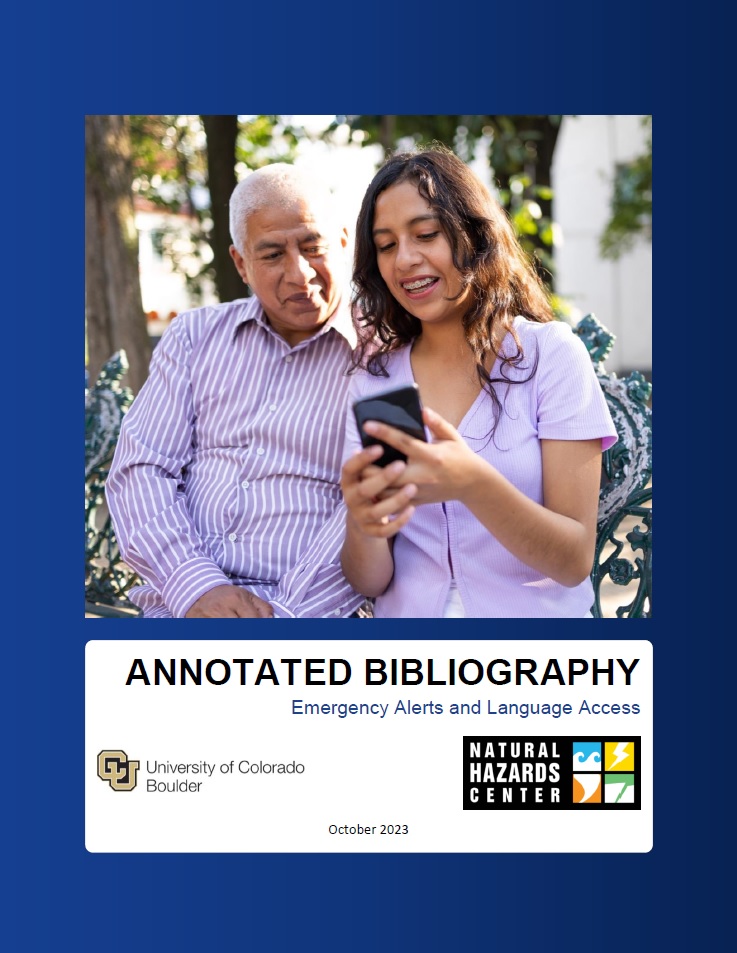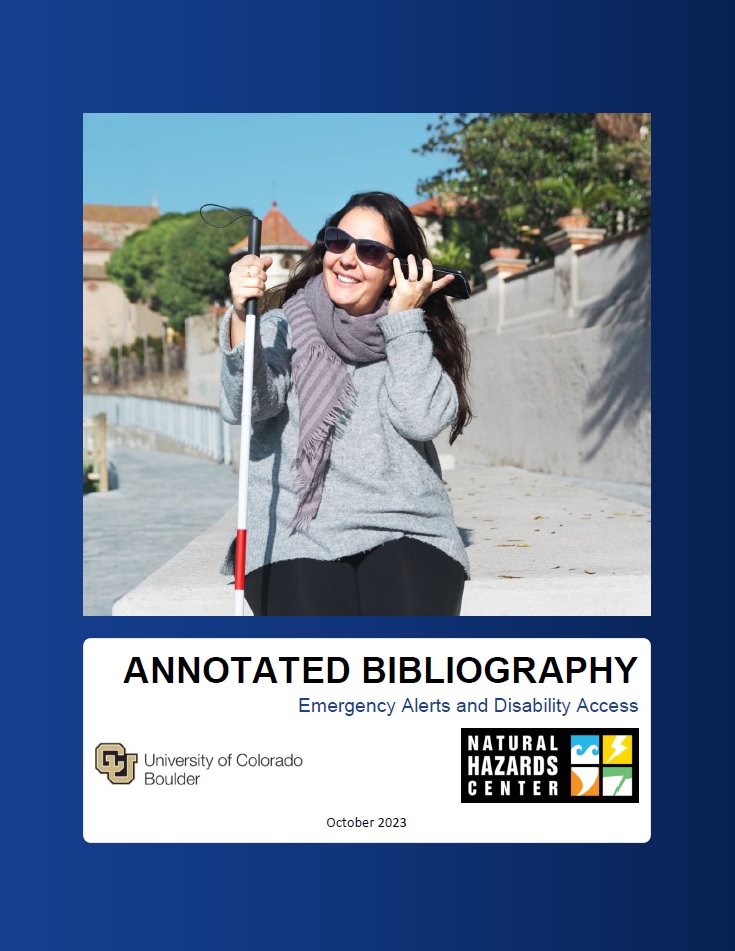Inclusive Emergency Alerts for Colorado: An Assessment and Recommendations for Language and Disability Considerations
Project Summary
This project culminated in a final English- and Spanish-language report that presents findings and recommendations from research conducted by the Natural Hazards Center in accordance with House Bill 23-1237. This study's purpose was to identify best practices for inclusive alerting and offer recommendations to improve current alert systems in Colorado that address language and access needs. This project collected information using three methods: a document review (62 documents) of research literature, a statewide survey of emergency response personnel (222 responses), and meetings with key partners (37 people).
Please click on the buttons below to download the Final Report. Learn more about the report’s findings, recommendations, and additional resources in the sections below.
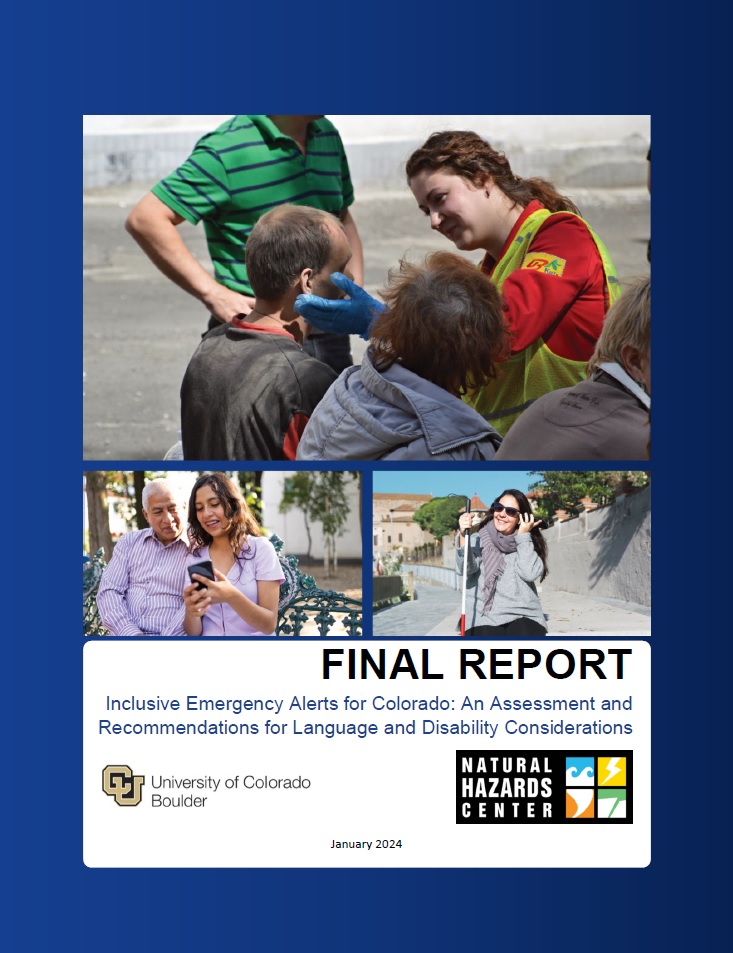
What Challenge Did This Project Address?
Emergency alerting—the process of sending emergency information to communities rapidly—has received heightened attention in the U.S. over the past decade. The Grizzly and Marshall Fires in 2020 and 2021, respectively, brought to light issues with alerting systems in Colorado when protocols were not in place to translate alert messages into non-English languages (Otárola, 2021); many people did not receive evacuation notices through their phones leaving them to make decisions without direction from authorities (Staeger and Bergum, 2022).
These and other recent events highlighted the need to examine Colorado alert systems and identify best practices and areas of improvement for some of Colorado’s most at-risk populations: individuals who have limited English proficiency (LEP) and people with disabilities who are Deaf, blind, Deaf-Blind or hard of hearing. Almost 900,000 Coloradans speak a language other than English and more than 250,000 have limited proficiency in English, meaning they have difficulty comprehending and communicating in English (Migration Policy Institute, 2021). About one in ten adults in Colorado—more than 500,000 people—have hearing and visual disabilities (Centers for Disease Control and Prevention, 2023) (Figure 2). The needs of those with visual and auditory disabilities and populations with LEP are often overlooked in emergency plans and can lead these populations to be underprepared and disproportionately impacted when a disaster occurs. As Colorado becomes more diverse and climate change exacerbates hazard risks, it is necessary to ensure practices and systems align with the needs of the public.
Findings and Recommendations
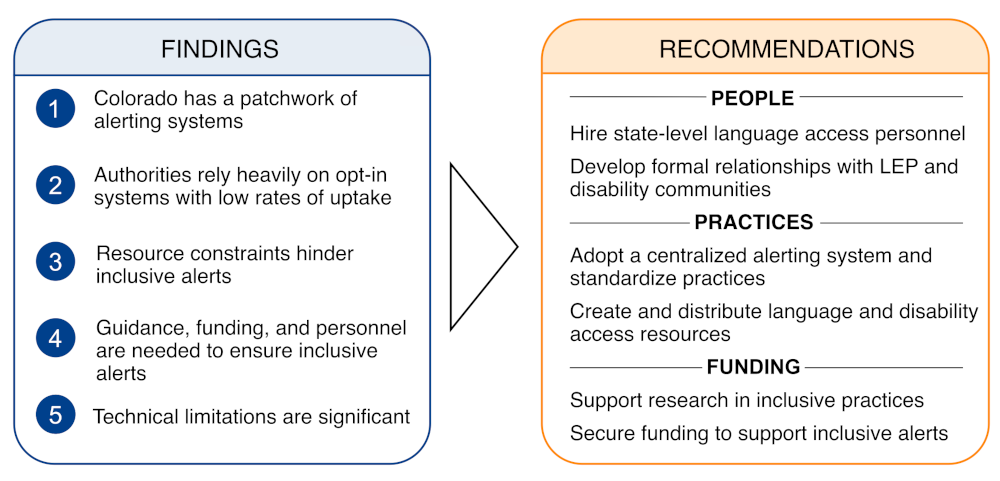
Additional Project Deliverables
Annotated Bibliographies
The document review for this project produced two annotated bibliographies on emergency alerting: one on language access and the other on disability access. These are only available in English currently.
Download by clicking on the images below.
Public Comment
Public comments were collected via an online form, through email, and during two virtual public meetings. These comments helped inform and strengthen the final report. You can review the feedback received at the links below:
*Virtual Meeting 2 is also available in American Sign Language or dubbed in Spanish. We are sorry, but due to technical issues, ASL and Spanish translations are not available for Virtual Meeting 1.
Presentations
- Inclusive Emergency Alerts [Poster] July 2025
- HB23-1237 Inclusive Language in Emergency Situations February 2024
- Inclusive Emergency Alerts: Recommendations for Language and Disability Access March 2023
Publications
MacPherson-Krutsky, Carson, Mary Angelica Painter, Melissa Villarreal. 2026. “Inclusive Emergency Alerts: Are Agencies Ready, Willing and Able?” Natural Hazards Review 27(1). https://doi.org/10.1061/NHREFO.NHENG-2400
Villarreal, Melissa, Carson MacPherson-Krutsky, and Mary Angelica Painter. 2025. “Barriers and Best Practices for Inclusive Emergency Alerts and Warnings.” International Journal of Disaster Risk Reduction. https://doi.org/10.1016/j.ijdrr.2025.105581
News Coverage
- Breeden, J. (2023, December 8). Inclusive Alerts in Colorado. Natural Hazards Center. https://hazards.colorado.edu/news/center-news/inclusive-alerts-in-colorado
- Prentzel, O. (2023, December 12). More staff, training needed in Colorado to create more inclusive emergency alert system, report says. Colorado Sun. https://coloradosun.com/2023/12/12/more-staff-training-needed-colorado-emergency-alert-system/
- Doak, O. (2023, December 13,). Comment period opens for CU Boulder report on state emergency alerts. Daily Camera. https://www.dailycamera.com/2023/12/12/comment-period-opens-for-cu-boulder-report-on-state-emergency-alerts/
- Zialcita, P. (2023, December 13). New CU report finds flaws with Colorado’s emergency alert practices. Colorado Public Radio News. https://www.cpr.org/2023/12/13/cu-report-finds-flaws-with-colorados-emergency-alerts/
Project Team
Project Research Lead: Carson MacPherson-Krutsky, Natural Hazards Center
Research Associate: Mary Angelica Painter, Natural Hazards Center
Graduate Research Assistant: Melissa Villarreal, Natural Hazards Center
Project Supervisor: Lori Peek, Director, Natural Hazards Center
Bill Sponsor: Elizabeth Velasco, State Representative (District 57), State of Colorado
Contributors: Garry Briese, Shirl Garcia, Micki Trost, Jennifer Kirkland, Jolie Breeden, Jennifer Tobin, Jeffrey Gunderson, and other members of the Natural Hazards Center Team
Alertas de emergencia inclusivas para Colorado: evaluación y recomendaciones para considerar el aspecto lingüístico y la discapacidad
Resumen del Proyecto
Este proyecto culminó en una informe final (en inglés y español) que presenta conclusiones y recomendaciones de investigaciones realizadas por el Centro de Amenazas Naturales de acuerdo con el Proyecto de ley de la Cámara 23-1237. El propósito de este estudio fue identificar las mejores prácticas recomendadas para alertas inclusivas y ofrecer recomendaciones para mejorar los sistemas de alerta actuales en Colorado, las cuales abordan las necesidades lingüísticas y de acceso. Este proyecto recopiló información utilizando tres métodos: revisión de documentos (62 documentos) de bibliografía de investigación, encuesta estatal de personal de respuesta a emergencias (222 respuestas) y reuniones con asociados clave (37 personas).
Haga clic en los siguientes botones para descargar el infrome final. Más información sobre las conclusiones, recomendaciones y recursos adicionales del informe son en las secciones siguientes.
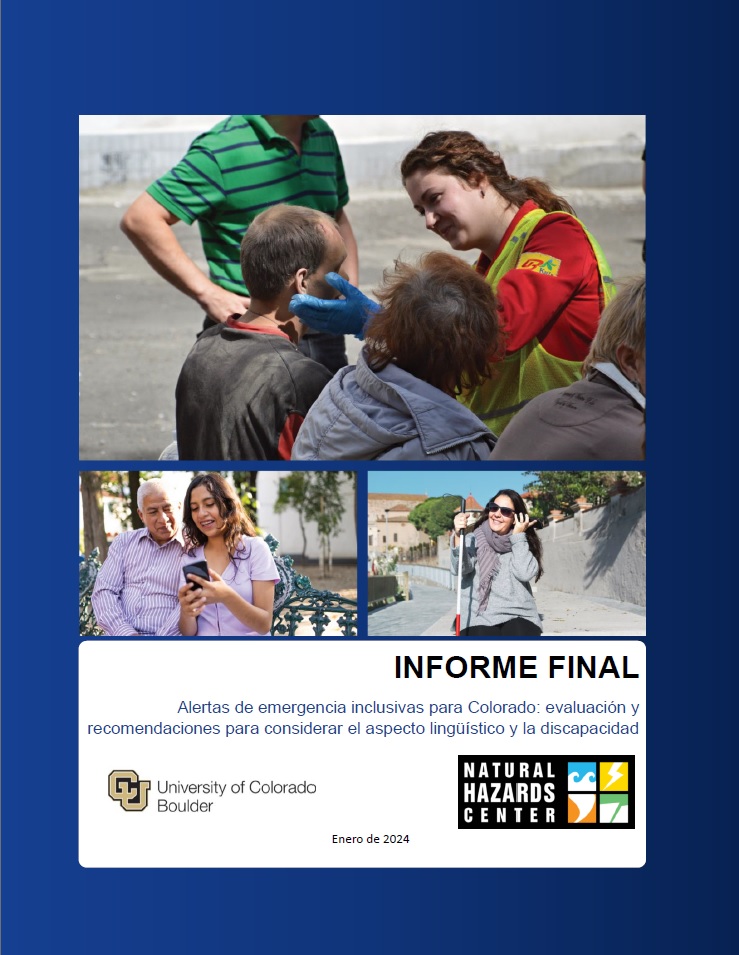
¿Qué reto abordó este proyecto?
Las alertas de emergencia— proceso de enviar información de emergencia a las comunidades rápidamente - han recibido una mayor atención en los estados unidos en la última década. Los incendios Grizzly y Marshall en el 2020 y el 2021, respectivamente, sacaron a la luz problemas con los sistemas de alerta en Colorado cuando no existían protocolos para traducir mensajes de alerta a idiomas distintos del inglés (Otárola, 2021) y muchas personas no recibieron avisos de evacuación a través de sus teléfonos, por lo que muchas de ellas tomaron decisiones sin haber recibido instrucciones de las autoridades (Staeger and Bergum, 2022).
Estos y otros evantos recientes destacaron la necesidad de examinar los sistemas de alerta de Colorado e identificar las mejores prácticas recomendadas y áreas de mejora para algunas de las poblaciones de mayor riesgo de Colorado: personas con dominio limitado de inglés y personas con discapacidad, específicamente las personas sordas, ciegas, sordo-ciegas o con problemas de audición.
Casi 900,000 habitantes de Colorado hablan un idioma diferente al inglés, y más de 250,000 habitantes de Colorado tienen un dominio limitado del inglés, lo que significa que tienen dificultades para comprender y comunicarse en este idioma (Migration Policy Institute, 2021). Aproximadamente uno de cada diez adultos en Colorado, más de 500,000 personas, tiene discapacidades auditivas y visuales (Centers for Disease Control and Prevention, 2023) Las necesidades de las personas con discapacidad y con dominio limitado de inglés, con frecuencia, se pasan por alto en los planes de emergencia y pueden llevar a que estas poblaciones estén mal preparadas y se vean afectadas de manera desproporcionada cuando ocurre un desastre. A medida que Colorado se vuelve más diverso y el cambio climático crea nuevas amenazas de peligros, es necesario garantizar que las prácticas y los sistemas se alineen con las necesidades del público.
Conclusiones y Recomendaciones
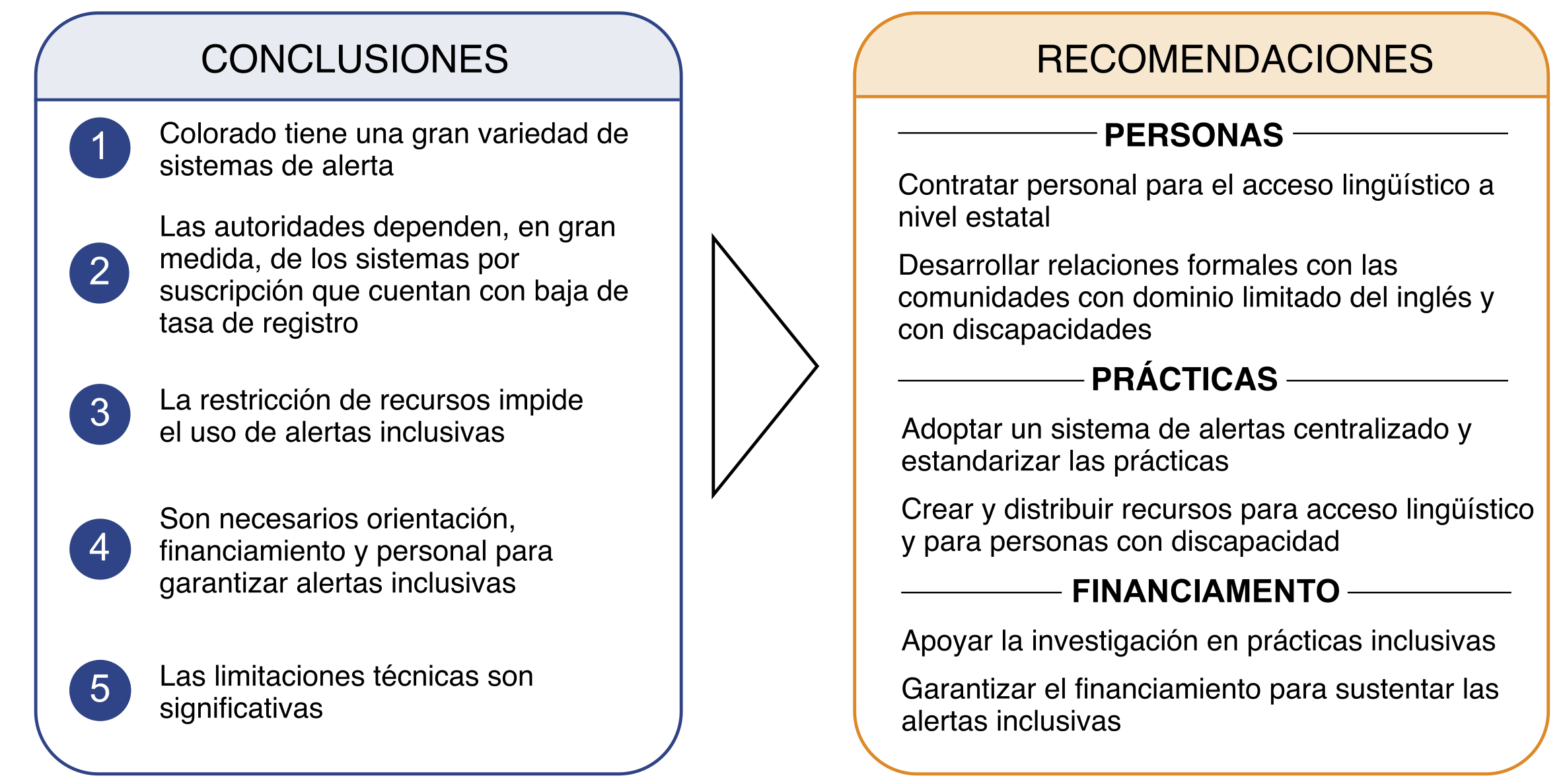
Resultados Adicionales del Proyecto
Las Bibliografías Comentadas
La revisión de documentos para este proyecto ha producido dos bibliografías comentadas sobre alertas de emergencia: una sobre acceso lingüístico y una para personas con discapacidad. Actualmente sólo están disponsibles en inglés.
Haga clic en las imágenes para descargarlas.
Comentario Público
Comentarios públicos se recogían a través de un formulario publicado en el sitio web del Centro de Amenazas Naturales, correo electrónico, y en dos sesiones de escucha virtuales. Estos comentarios contribuyeron a fundamentar y reforzar el informe final. Puede revisar los comentarios en los enlaces siguientes:
*La sesión de escucha 2 también está disponible en lenguaje de señas americano o en español. Lo sentimos, pero por problemas técnicos, las traducciones en lenguaje de señas americano y en español no están disponibles para la sesión de escucha virtual 1.
Presentaciones
- Alertas de emergencia inclusivas [póster] julio 2025 - sólo en inglés
- HB23-1237 Lenguaje inclusivo en situaciones de emergencia febrero 2024 - sólo en inglés
- Alertas de emergencia inclusivas: evaluación y recomendaciones para considerar el aspecto lingüístico y la discapacidad marzo 2023 - sólo en inglés
Publicaciones
MacPherson-Krutsky, Carson, Mary Angelica Painter, Melissa Villarreal. 2026. “Inclusive Emergency Alerts: Are Agencies Ready, Willing and Able?” Natural Hazards Review 27(1). https://doi.org/10.1061/NHREFO.NHENG-2400
Villarreal, Melissa, Carson MacPherson-Krutsky, and Mary Angelica Painter. 2025. “Barriers and Best Practices for Inclusive Emergency Alerts and Warnings.” International Journal of Disaster Risk Reduction. https://doi.org/10.1016/j.ijdrr.2025.105581
En las Noticias
- Breeden, J. (2023, December 8). Inclusive Alerts in Colorado. Natural Hazards Center. https://hazards.colorado.edu/news/center-news/inclusive-alerts-in-colorado
- Prentzel, O. (2023, December 12). More staff, training needed in Colorado to create more inclusive emergency alert system, report says. Colorado Sun. https://coloradosun.com/2023/12/12/more-staff-training-needed-colorado-emergency-alert-system/
- Doak, O. (2023, December 13,). Comment period opens for CU Boulder report on state emergency alerts. Daily Camera. https://www.dailycamera.com/2023/12/12/comment-period-opens-for-cu-boulder-report-on-state-emergency-alerts/
- Zialcita, P. (2023, December 13). New CU report finds flaws with Colorado’s emergency alert practices. Colorado Public Radio News. https://www.cpr.org/2023/12/13/cu-report-finds-flaws-with-colorados-emergency-alerts/
Equipo de Investigación y Evaluación - El Centro de Amenazas Naturales
La Directora del Proyecto: Carson MacPherson-Krutsky, El Centro de Amenazas Naturales
Investigadora Asociada: Mary Angelica Painter, El Centro de Amenazas Naturales
Asistente Graduada de Investigación: Melissa Villarreal, El Centro de Amenazas Naturales
La Supervisora del Proyecto: Lori Peek, Director, El Centro de Amenazas Naturales
La Promotora del Proyecto de Ley: Elizabeth Velasco, Representante de Estado (Distrito 57), Estado de Colorado
Colaboradores: Garry Briese, Shirl Garcia, Micki Trost, Jennifer Kirkland, Jolie Breeden, Jennifer Tobin, Jeffrey Gunderson, y otros miembros del equipo del Centro de Amenazas Naturales
